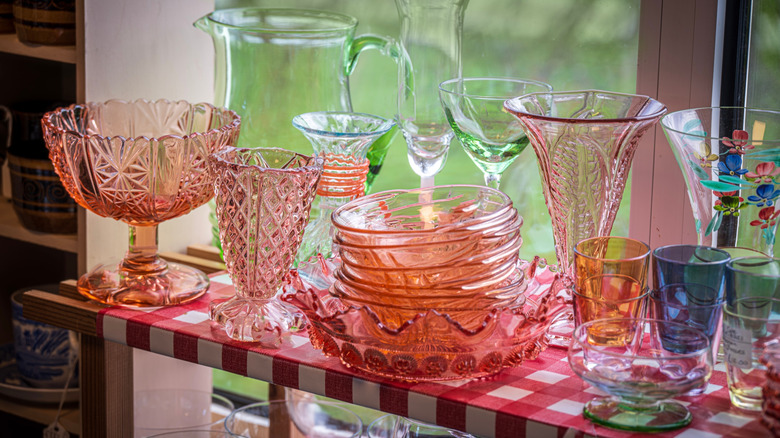Quick Tips That Make It Easier To Find Genuine Depression Glass At Estate Sales
Perhaps the most remarkable thing about collectible Depression glass is the fact that it's collectible. It's not surprising that it was originally manufactured cheaply; things that were originally inexpensive become collectibles all the time. And while most Depression glass possesses an undeniable beauty, that's not the reason, either; the expensive and handmade so-called "elegant glass" of the period is more finely crafted. But both reflected an ornate sensibility more in keeping with the art deco style than with the more function-centered modernism that was taking hold at the time, and today, some Depression glass pieces can cost as much as the fancy glassware of the same period. Because of this, it's one of the prized items you should never overlook when shopping at estate sales.
Depression glass has been making a comeback in recent years, and Hunker spoke exclusively with Dr. Lori Verderame, Ph.D., an antiques appraiser known for her numerous television appearances and helpful videos shared on her YouTube channel and website, about the ins and outs of identifying potentially valuable Depression glass at estate sales. She started by giving us a primer on Depression glass and its collectibility. "It is colorful and was popular in the Great Depression as an alternative to expensive china for table settings," Verderame explained. "While colored glass has been used going back centuries, Depression glass is best known by its colors. Collectors look for Depression glass most actively in pink, amber, and green." The value of most Depression glass pieces, she said, usually ranges from $20 to $200.
Identifying collectible depression glass
People collect for a lot of reasons, from nostalgia to historical authenticity to simple obsession. When Hunker spoke exclusively with antiques expert Dr. Lori Verderame, known popularly as "Dr. Lori," she touched on the motivations of Depression glass collectors. "Many people collect Depression glass as a way to recall what Grandma's dining table looked like," Verderame said, "or to amass a collection of Depression glass in one color, or by a particular manufacturer, or pattern." More than 100 patterns of Depression glassware were manufactured by as many as 20 companies, including Federal, Anchor Hocking, and Jeannette.
When you run across glassware at an estate sale, one potential problem to be on the lookout for is the piece's period. "There are reproduction pieces of Depression glass made in the 1970s," Verderame explained, "but early 20th century Depression glass is easily recognizable by its slim appearance, muted colors, and popular patterns featuring grapes, starbursts, [and] leaves." And because these were glassware pieces made for daily use nearly a century ago, there could also be some wear and tear. "Be sure to check the condition of any piece of Depression glass," Verderame said. "The intricate patterns can hide chips or cracks which devalue a piece."
But don't be turned off if you spot Depression glass with manufacturing imperfections and inconsistencies. These baked-in flaws don't seem to negatively affect the value of Depression glass, and might actually increase it. It's another way an inexpensive product that once appeased the impoverished people of the Great Depression has taken on surprising value — for those who are lucky enough to find it, at least.

